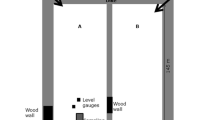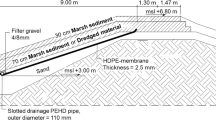Abstract
Because of the shallow relief in Belgium and northern France, the dredging of waterways generates significant quantities of sediments for which few valorization pathways are validated. Waterways operators and public authorities are still waiting for efficient valorization solutions. The VALSE project, funded by the Interreg V FWVl program, aims to validate valorization pathways through large-scale works that promote a good integration in territories and a sustainable use. In this context, landscaping could be an upgrading solution; hence, a mound made with unpolluted sediments is ecologically and ecotoxicologically monitored over time to assess if dredged materials are harmful for the environment. An embankment near the studied site was chosen as a reference. The monitoring consists of, on the one hand, in situ flora and substrate macro-invertebrates surveys. On the other hand, ecotoxicity tests are performed on sediments and soil respectively taken from the mound and the embankment: the activity of nitrifying bacteria in these substrates and the reproduction of an earthworm (Eisenia fetida) are studied. First, results show that the sediments do not seem to impact negatively plant colonization or the settlement of substrate macro-invertebrates. About laboratory testing, sediments do not seem to interfere with natural nitrification process and E. fetida reproduction seems equivalent in sediments and embankment soil. These results do not allow drawing any definite conclusion because they relate to a first year of experimentation only, but they tend towards a good integration of the mound in the surrounding environment for the monitored parameters.





Similar content being viewed by others
References
Albanell E, Plaixats J, Cabrero T (1988) Chemical changes during vermicomposting (Eisenia fetida) of sheep manure mixed with cotton industrial wastes. Biol Fertil Soils 6(3). https://doi.org/10.1007/bf00260823
Ågren GI, Weih M (2012) Plant stoichiometry at different scales: element concentration patterns reflect environment more than genotype. New Phytol 194(4):944–952. https://doi.org/10.1111/j.1469-8137.2012.04114.x
Anderson JM, Ingram JSI (1993) Chemical analyses. In: Anderson JM, Ingram JSI (eds) Tropical soil biology and fertility - a handbook of methods. CAB International, Wallingford, p 240
Baker GH, Lee KE (1993) Earthworms. In: Carter MR (ed) Soil sampling and methods of analysis. Lewis Publishers, Boca Raton, Florida, pp 359–378
Bellmann H (2006) Insectes et principaux arachnides (Insects and main arachnids), Vigot, in French
Bellosi B, Selldorf P, Schoenenberger N (2011) Exploring the flora on inert landfill sites in Southern Ticino (Switzerland). Bauhinia 23:1–15
Benzerzour M, Abriak N, Mansi R (2016) Managing valorization of dredged sediments via an innovative mathematical model used for civil engineering application. Int J GEOMATE 11(26):2679–2683
Bouhoulle E, Louvieaux, J, Haouche-Belkessam L (2016) VALSOLINDUS, a demonstration project of sediments valorization. 5th International Symposium on Sediment Management, Canada, Montreal.
Boutouil M, Abriak N, Saussaye L, Benzerzour M (2012) Méthodologie SETARMS de caractérisation et de traitement des sédiments de dragage marins (SETARMS methodology of characterization and treatments of marine dredging sediments) XIIèmes Journées Nationales Génie Côtier – Génie Civil Cherbourg. https://doi.org/10.5150/jngcgc.2012.109-B, in French
Doran JW, Jones AJ, Blair JM, Bohlen PJ, Freckman DW (1996) Soil invertebrates as indicators of soil quality. SSSA Special Publication. https://doi.org/10.2136/sssaspecpub49.c16
Chan YSG, Chu LM, Wong MH (1997) Influence of landfill factors on plants and soil fauna—an ecological perspective. Environ Pollut 97(1-2):39–44. https://doi.org/10.1016/s0269-7491(97)00082-1
Chen YL, Hu HW, Han HY, Du Y, Wan SQ, Xu ZW, Chen BD (2014) Abundance and community structure of ammonia-oxidizing Archaea and Bacteriain response to fertilization and mowing in a temperate steppe in Inner Mongolia. FEMS Microbiol Ecol 89(1):67–79. https://doi.org/10.1111/1574-6941.12336
Chinery M (2005) Insectes de France et d’Europe occidentale (Insects of France and Western Europe), Flammarion, in French
Cluzeau D, Guernion M, Chaussod R, Martin-Laurent F, Villenave C, Cortet J, Ruiz-Camacho N, Pernin C, Mateille T, Phillipot L, Bellido A, Rougé L, Arrouays D, Bispo A, Pérès G (2012) Integration of biodiversity in soil quality monitoring: baselines for microbial and soil fauna parameters for different land-use types. Eur J Soil Biol 49:63–72. https://doi.org/10.1016/j.ejsobi.2011.11.003
Decaëns T, Dutoit T, Alard D, Lavelle P (1998) Factors influencing soil macrofaunal communities in post-pastoral successions of western France. Appl Soil Ecol 9(1-3):361–367. https://doi.org/10.1016/s0929-1393(98)00090-0
Diekmann M (2003) Species indicator values as an important tool in applied plant ecology – a review. Basic Appl Ecol 4(6):493–506. https://doi.org/10.1078/1439-1791-00185
Dulière JF, Malaisse F, Tanghe M (1995) Répertoire des groupes écologiques du fichier écologique des essences (Directory of Ecological Groups of Ecological File of Essences), Ministère de la Région wallonne, in French
Dyguś KH (2013) Vegetation of industrial waste landfill within the agglomeration of the capital city of Warsaw. J Ecol Eng 14(1):22–32. https://doi.org/10.5604/2081139X.1031532
Fischer J, Lindenmayer DB (2007) Landscape modification and habitat fragmentation: a synthesis. Glob Ecol Biogeogr 16(3):265–280. https://doi.org/10.1111/j.1466-8238.2007.00287.x
Henneresse T (2016) Inventaire floristique des Centres d’Enfouissement technique de Habay et de Tenneville (Province de Luxembourg, Belgique) (Flora survey of the Technical Burying Centers of Habay and Tenneville (province of Luxembourg, Belgium)), Dumortiera, 109. 8–22, in French
Joimel S, Cortet J, Jolivet CC, Saby NPA, Chenot ED, Branchu P, Consalès JN, Lefort C, Morel JL, Schwartz C (2016) Physico-chemical characteristics of topsoil for contrasted forest, agricultural, urban and industrial land uses in France. Sci Total Environ 545–546:40–47. https://doi.org/10.1016/j.scitotenv.2015.12.035
Lavelle P, Decaëns T, Aubert M, Barot S, Blouin M, Bureau F, Margerie P, Mora P, Rossi JP (2006) Soil invertebrates and ecosystem services. Eur J Soil Biol 42:S3–S15. https://doi.org/10.1016/j.ejsobi.2006.10.002
Lemière B, Michel P, Abriak N, Haouche L, Laboudigue A, Alalry C, Badreddine R, Hazebrouck B, Meerseman J (2010) The GeDSeT project: constitution of a decision support tool (DST) for the management and material recovery of waterways sediments in Belgium and Northern France. Déchets, Sciences et Techniques, 57, 10 p. <hal-00691510>
Lemière B (2017) Interreg FWVl Project VALSE. SedNet Newsletter. https://sednet.org/news/newsletter/newsletter-september-2017/. Accessed September 2017
Le Roux X, Bardy M, Loiseau P, Louault F (2003) Stimulation of soil nitrification and denitrification by grazing in grasslands: do changes in plant species composition matter? Oecologia 137(3):417–425. https://doi.org/10.1007/s00442-003-1367-4
Nahmani J, Lavelle P (2002) Effects of heavy metal pollution on soil macrofauna in a grassland of Northern France. Eur J Soil Biol 38(3-4):297–300. https://doi.org/10.1016/s1164-5563(02)01169-x
NBN “Soil quality – determination of potential nitrification and inhibition of nitrification – rapid test by ammonium oxidation”, ISO 15685 F, 2012, 12 p
NBN “Soil quality – effects of pollutants on earthworms – part 2: determination of effects on reproduction of Eisenia fetida/Eisenia andrei”, ISO 11268-2, 2015, 21 p
NBN “Soil quality – sampling of soil invertebrates – part 5: sampling and extraction of soil macro-invertebrates.” EN ISO 23611-5:2013 F, 2011, 12 p
Newman J (1988) The soil fauna other than protozoa. In: Wild A (ed) Soil conditions and plant growth, pp 500–525
Olson PE, Fletcher JS (2000) Ecological recovery of vegetation at a former industrial sludge basin and its implications to phytoremediation. Environ Sci Pollut Res 7(4):195–204. https://doi.org/10.1007/bf02987348
Orozco FH, Cegarra J, Trujillo LM, Roig A (1996) Vermicomposting of coffee pulp using the earthworm Eisenia fetida: effects on C and N contents and the availability of nutrients. Biol Fertil Soils 22(1-2):162–166. https://doi.org/10.1007/bf00384449
Paoletti MG (1999) Using bioindicators based on biodiversity to assess landscape sustainability. In: Paoletti MG (eds) Invertebrate biodiversity as bioindicators of sustainable landscapes, vol 1–18. Elservier, Amsterdam. https://doi.org/10.1016/B978-0-444-50019-9.50004-2
Patra AK, Abbadie L, Clays-Josserand A, Degrange V, Grayston SJ, Guillaumaud N, Loiseau P, Louault F, Mahmood S, Nazaret S, Philippot L, Poly F, Prosser JI, Roux XL (2006) Effects of management regime and plant species on the enzyme activity and genetic structure of N-fixing, denitrifying and nitrifying bacterial communities in grassland soils. Environmental Microbiology 8(6):1005–1016
Pereira F, Koller E, Lucion C, Hiver JM, Libert Y (2010) Integrated and sustainable solutions for the treatment and valorization of dredging sediments: the SOLINDUS project. 32nd PIANC Congress. Liverpool, United-Kingdom.
Pérès G, Vandenbulcke F, Guernion M, Hedde M, Beguiristain T, Douay F, Houot S, Piron D, Richard A, Bispo A, Grand C, Galsomies L, Cluzeau D (2011) Earthworm indicators as tools for soil monitoring, characterization and risk assessment. An example from the national Bioindicator programme (France). Pedobiologia 54:S77–S87. https://doi.org/10.1016/j.pedobi.2011.09.015
Rahmonov O, Parusel T (2011) Vegetation succession and soil development in an area transformed by human impact - reclaimed ash landfills. The 8th International Conference Environmental Engineering, May 19 - 20, 2011. Vilnius, Lithuania
Persson T, Wirén A (1995) Nitrogen mineralization and potential nitrification at different depths in acid forest soils. In: Nilsson L.O., Hüttl R.F., Johansson U.T. (eds) Nutrient uptake and cycling in forest ecosystems. Developments in Plant and Soil Sciences, vol 62. Springer, Dordrecht
Rebele F, Lehmann C (2002) Restoration of a Landfill Site in Berlin, Germany by Spontaneous and Directed Succession. Restoration Ecology 10(2):340–347
Remon E, Bouchardon JL, Cornier B, Guy B, Leclerc JC, Faure O (2005) Soil characteristics, heavy metal availability and vegetation recovery at a former metallurgical landfill: Implications in risk assessment and site restoration. Environmental Pollution 137(2):316–323
Robson T, Lavorel S, Clement J, Le Roux X (2007) Neglect of mowing and manuring leads to slower nitrogen cycling in subalpine grasslands. Soil Biol Biochem 39(4):930–941. https://doi.org/10.1016/j.soilbio.2006.11.004
Sanchez-Hernandez JC (2006) Earthworm biomarkers in ecological risk assessment. In: Ware GW et al (eds) Reviews of environmental contamination and toxicology, vol 188. Springer, New York, NY
Smolders E, Brans K, Coppens F, Merckx R (2001) Potential nitrification rate as a tool for screening toxicity in metal-contaminated soils. Environ Toxicol Chem 20(11):2469–2474. https://doi.org/10.1002/etc.5620201111
Sorensen T (1948) A method of establishing groups of equal amplitude in plant sociology based on similarity of species content and its application to analyses of the vegetation on Danish commons. K Dan Vidensk Selsk Biol Skr 5(4):1–34
Suthar S (2009) Vermicomposting of vegetable-market solid waste using Eisenia fetida: impact of bulking material on earthworm growth and decomposition rate. Ecol Eng 35(5):914–920. https://doi.org/10.1016/j.ecoleng.2008.12.019
Tripathi G, Bhardwaj P (2004) Decomposition of kitchen waste amended with cow manure using an epigeic species (Eisenia fetida) and an anecic species (Lampito mauritii). Bioresour Technol 92(2):215–218. https://doi.org/10.1016/j.biortech.2003.08.013
Van der Heijden MGA, Bardgett RD, van Straalen NM (2008) The unseen majority: soil microbes as drivers of plant diversity and productivity in terrestrial ecosystems. Ecol Lett 11(3):296–310. https://doi.org/10.1111/j.1461-0248.2007.01139.x
Verwij GH (2018) Preventing land subsidence: using sediment as a resource (USAR). 6th International Symposium on Sediment Management, San Cristobal de Las Casas, Mexico
Vincent Q, Leyval C, Beguiristain T, Auclerc A (2018) Functional structure and composition of Collembola and soil macrofauna communities depend on abiotic parameters in derelict soils. Appl Soil Ecol 130:259–270. https://doi.org/10.1016/j.apsoil.2018.07.002
Wróbel M, Nachowicz K, Bashutska U (2013) Floristic diversity of municipal wastes heaps on the reclaimed landfills near Szczecin (Western Pomerania, Poland). Науковий вісник НЛТУ України 23(14):43–51
Acknowledgments
The authors wish to thank the VALSE team for their technical and scientific support (www.valse.info).
Funding
This study was financially supported by the ERDF European program, Interreg V FWVl, and the Walloon Region of Belgium.
Author information
Authors and Affiliations
Corresponding author
Additional information
Responsible editor: Philippe Garrigues
Publisher’s note
Springer Nature remains neutral with regard to jurisdictional claims in published maps and institutional affiliations.
Electronic supplementary material
ESM 1
(PDF 549 kb)
Rights and permissions
About this article
Cite this article
Liénard, F., Haouche, L. Monitoring of a mound made of sediments: exploring landscaping as a way to upgrade dredged materials (VALSE project). Environ Sci Pollut Res 27, 15994–16003 (2020). https://doi.org/10.1007/s11356-019-06375-5
Received:
Accepted:
Published:
Issue Date:
DOI: https://doi.org/10.1007/s11356-019-06375-5




